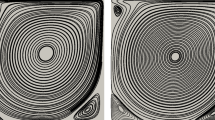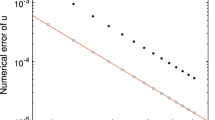Abstract
The paper introduces a new algorithm for solving the finite difference equations at the upper time level of an implicit scheme that approximates the Navier–Stokes system in the vorticity-stream function formulation. The algorithm requires no iterations and computes the corresponding discrete solution exactly. It is based on the method of difference potentials and allows one to efficiently address the well-known difficulties typical for this type of formulations—two boundary conditions for the stream function and no boundary conditions for vorticity.
Abstract for the translation The paper is translated from the Russian by S. Tsynkov (tsynkov@math.ncsu.edu). The original [12] was published more than 20 years ago (the actual Russian citation is [14]). It has not been previously translated into English and went largely unnoticed by the numerical analysis and scientific computing research community. Yet it presents an important contribution to the discipline as it offers a full answer to the question that has long been outstanding. The incompressible Navier–Stokes equations in the vorticity-stream function formulation require two boundary conditions for the stream function and no boundary conditions for vorticity. A standard approach to addressing numerically the apparent overdetermination in one variable and underdetermination in the other was through the use of iterations. Instead, work [12] shows the unambiguous way of discretizing the Navier–Stokes system implicitly and solving the resulting finite difference equations on the upper time level exactly. It is equivalent to deriving the correct non-local boundary condition for vorticity.
Note from the translator My Ph.D. advisor Prof. Ryaben’kii and my postdoc mentor Prof. Abarbanel were friends. They interacted closely and participated in joint projects at ICASE (NASA Langley Research Center) in the late 1990s and early 2000s. Prof. Ryaben’kii visited Tel Aviv several times, and Prof. Abarbanel traveled to Moscow in 2013 to celebrate Prof. Ryaben’kii’s 90th birthday. This paper, which was written by Prof. Ryaben’kii with his Ph.D. student at the time, V. Torgashov, provides a well-deserved tribute to a friend from a friend.






Similar content being viewed by others
Notes
From the translator: The Russian term “внутренние граничные условию ” has previously been translated into English as “internal boundary conditions,” see, e.g., [8]. A more accurate English term may be “intrinsic boundary conditions.”
References
Anderson, D.A., Tannehill, J.C., Pletcher, R.H.: Computational Fluid Mechanics and Heat Transfer. Series in Computational Methods in Mechanics and Thermal Sciences. Hemisphere Publishing Corp., Washington, DC (1984)
Fletcher, C.A.J.: Computational Techniques for Fluid Dynamics. Specific Techniques for Different Flow Categories. Springer Series in Computational Physics, 2nd edn. Springer, Berlin (1991). https://doi.org/10.1007/978-3-642-58239-4
Ghia, U., Ghia, K.N., Shin, C.T.: High-Re solutions for incompressible flow using the Navier–Stokes equations and a multigrid method. J. Comput. Phys. 48(3), 387–411 (1982). https://doi.org/10.1016/0021-9991(82)90058-4. http://www.sciencedirect.com/science/article/pii/0021999182900584
Moiseenko, B.D., Fryazinov, I.V.: Conservative difference schemes for equations of an incompressible viscous fluid in Euler variables. Zhurnal Vychisl. Mat. i Mat. Fiz. 21(5), 1180–1191 (1981)
Pletcher, R.H., Tannehill, J.C., Anderson, D.A.: Computational Fluid Mechanics and Heat Transfer, Series in Computational and Physical Processes in Mechanics and Thermal Sciences, 3rd edn. CRC Press, Boca Raton (2013)
Roache, P.J.: Computational Fluid Dynamics. Hermosa Publishers, Albuquerque, NM (1976). With an appendix (“On artificial viscosity”) reprinted from J. Comput. Phys. 10(2) 169–184 (1972), Revised printing
Roache, P.J.: Fundamentals of Computational Fluid Dynamics. Hermosa Publishers, Albuquerque (1998)
Ryaben’kii, V.S.: The method of internal boundary conditions in the theory of boundary value difference problems. Russ. Math. Surv. 26, 117–176 (1971)
Ryaben’kii, V.S.: Difference Potentials Method for Some Problems of Continuous Media Mechanics. Nauka, Moscow (1987). (In Russian)
Ryaben’kii, V.S.: Introduction to Computational Mathematics [Vvedenie v vychislitel’nuyu matematiku]. Fizmatlit “Nauka”, Moscow (1994). [Russian]
Ryaben’kii, V.S.: Method of Difference Potentials and Its Applications, Springer Series in Computational Mathematics, vol. 30. Springer, Berlin (2002)
Ryaben’kii, V.S., Torgashov, V.A.: A noniterative method for solving an implicit difference scheme for Navier–Stokes equations in vorticity-stream function variables. Mat. Model. 8(10), 100–112 (1996). [in Russian]
Ryaben’kii, V.S., Tsynkov, S.V.: A Theoretical Introduction to Numerical Analysis. Chapman & Hall/CRC, Boca Raton (2007)
Рябенький, В.С., Торгашов, В.А.: Безытерационный способ решения неявной разностной схемы для уравнений Навье-Стокса в переменных: завихренность и функция тока. Математическое Моделирование 8(10), 100–112 (1996)
Acknowledgements
This work was supported by the Russian Foundation for Fundamental Research, Project 96-01-01577.
Author information
Authors and Affiliations
Corresponding author
Additional information
This publication is dedicated to the memory of Professor Saul Abarbanel.
Publisher's Note
Springer Nature remains neutral with regard to jurisdictional claims in published maps and institutional affiliations.
Published with permission from Mathematical Modeling.
As the corresponding author is unavailable the translator would correspond on behalf of the authors.
Rights and permissions
About this article
Cite this article
Ryaben’kii, V.S., Torgashov, V.A. An Iteration-Free Approach to Solving the Navier–Stokes Equations by Implicit Finite Difference Schemes in the Vorticity-Stream Function Formulation. J Sci Comput 81, 1136–1149 (2019). https://doi.org/10.1007/s10915-019-00926-1
Received:
Revised:
Accepted:
Published:
Issue Date:
DOI: https://doi.org/10.1007/s10915-019-00926-1




